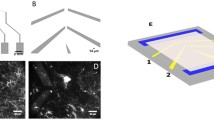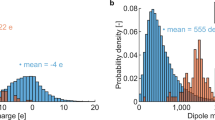Abstract
Microtubules composed of tubulin heterodimers represent highly dynamic structures. These structures are essential for basic cellular functions, such as cell division. Microtubules can grow or shrink in response to environmental signals, principally chemical cues. Here, we provide an alternative—physical—strategy to modulate tubulin properties and its self-assembly process. The conformation and electrical properties of tubulin subunits are modulated by nanosecond electropulse signals. The formed structures of electrically treated tubulin are tightly linked to the degree of conformational and electrical properties changes induced by nanosecond electropulses. This strategy opens a new way for controlling the self-assembly process in biomolecules as well as in bioinspired materials.
Access this chapter
Tax calculation will be finalised at checkout
Purchases are for personal use only
Similar content being viewed by others
References
Pellegrini L, Wetzel A, Grannó S, Heaton G, Harvey K (2017) Back to the tubule: microtubule dynamics in Parkinson’s disease. Cell Mol Life Sci 74(3):409–434
Bachand GD, Spoerke ED, Stevens MJ (2015) Microtubule-based nanomaterials: exploiting nature’s dynamic biopolymers. Biotechnol Bioeng 112:1065–1073
Dumontet C, Jordan MA (2010) Microtubule-binding agents: a dynamic field of cancer therapeutics. Nat Rev Drug Discov 9(10):790–803
Chafai DE, Sulimenko V, Havelka D, Kubínová L, Dráber P, Cifra M (2019) Reversible and irreversible modulation of tubulin self-assembly by intense nanosecond pulsed electric fields. Adv Mater 31(39):e1903636
Chafai DE, Cifra M (2019) Modulation of micro/nanobiostructure’s functions by intense nanosecond pulsed electric fields. In: 2019 international conference on advanced electrical engineering (ICAEE), pp 1–3
Chafai DE, Vostárek F, Dráberová E, Havelka D, Arnaud-Cormos D, Leveque P, Janáček J, Kubínová L, Cifra M, Dráber P (2020) Microtubule cytoskeleton remodeling by nanosecond pulsed electric fields. Adv Biosys 4(7):e2000070
Havelka D, Chafai DE, Krivosudský O, Klebanovych A, Vostárek F, Kubínová L, Dráber P, Cifra M (2020) Nanosecond pulsed electric field lab-on-chip integrated in super-resolution microscope for cytoskeleton imaging. Adv Mater Technol 5:1900669
Lakowicz JR (2006) Principles of fluorescence spectroscopy. Springer Science, New York
Gell C, Friel CT, Borgonovo B, Drechsel DN, Hyman AA, Howard J (2011) Purification of tubulin from porcine brain. Methods Mol Biol 777:15–28
Acknowledgments
The authors acknowledge the support from the Institute of Physiology of the Czech Academy of Sciences, and the support from the Czech Science Foundation (D.E.Ch. - 17-11898S, M.C. - 20-06873X).
Author information
Authors and Affiliations
Corresponding author
Editor information
Editors and Affiliations
Rights and permissions
Copyright information
© 2022 The Author(s), under exclusive license to Springer Science+Business Media, LLC, part of Springer Nature
About this protocol
Cite this protocol
Chafai, D.E., Cifra, M. (2022). Electro-Modulation of Tubulin Properties and Function. In: Inaba, H. (eds) Microtubules. Methods in Molecular Biology, vol 2430. Humana, New York, NY. https://doi.org/10.1007/978-1-0716-1983-4_4
Download citation
DOI: https://doi.org/10.1007/978-1-0716-1983-4_4
Published:
Publisher Name: Humana, New York, NY
Print ISBN: 978-1-0716-1982-7
Online ISBN: 978-1-0716-1983-4
eBook Packages: Springer Protocols




